
Carl Johann Maximovich was a Russian botanist. Maximovich spent most of his life studying the flora of the countries he had visited in the Far East, and naming many new species. He worked at the Saint Petersburg Botanical Gardens from 1852 as curator of the herbarium collection, becoming Director in 1869.
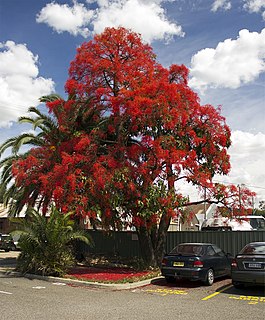
Brachychiton acerifolius, commonly known as the Illawarra flame tree, is a large tree of the family Malvaceae native to subtropical regions on the east coast of Australia. It is famous for the bright red bell-shaped flowers that often cover the whole tree when it is leafless. Along with other members of the genus Brachychiton, it is commonly referred to as a Kurrajong.

Brachychiton rupestris, commonly known as the narrow-leaved bottle tree or Queensland bottle tree, is a tree in the family Malvaceae native to Queensland, Australia. Discovered and described by Sir Thomas Mitchell and John Lindley in 1848, it gained its name from its bulbous trunk, which can be up to 3.5 metres (11 ft) diameter at breast height (DBH). Reaching 10–25 metres (33–82 ft) high, the Queensland bottle tree is deciduous, losing its leaves between September and December. The leaves are simple or divided, with one or more narrow leaf blades up to 11 centimetres (4 in) long and 2 centimetres (0.8 in) wide. Cream-coloured flowers appear from September to November, and are followed by woody boat-shaped follicles that ripen from November to May. No subspecies are recognised.

Brachychiton populneus, commonly known as the kurrajong, is a small to medium-sized tree found naturally in Australia in a diversity of habitats from wetter coastal districts to semi-arid interiors of Victoria, New South Wales and Queensland. The extended trunk is a water storage device for survival in a warm dry climate. The bell-shaped flowers are variable in colour while the leaves vary considerably in shape. The leaves are either simple and pointed, or may be 3–9 lobed. Saplings grow from a drought and fire resistant tap-rooted tuber.
Maximowicz's vole is a species of rodent in the family Cricetidae. It is found in northeastern China, Mongolia, and eastern Russia.

Crataegus maximowiczii is a species of hawthorn with fruit that are red to purple-black.
Sterculioideae is a subfamily of the family Malvaceae containing evergreen and deciduous trees and shrubs.
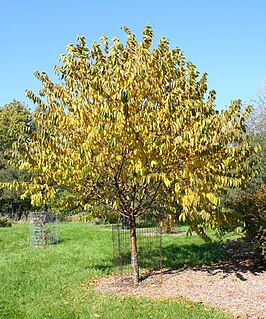
Prunus maximowiczii, known as Korean cherry, Korean mountain cherry, or Miyama cherry, is a small, fruiting cherry tree that can be found growing wild in northeastern Asia and Eurasia.
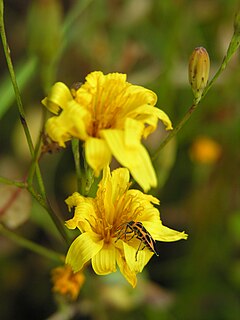
Hololeion is a genus of East Asian flowering plants in the dandelion family. It is native to Japan, Korea, China, and the Russian Far East.

Brachychiton bidwillii, commonly known as the little kurrajong, is a small tree of the genus Brachychiton found in tropical areas of eastern Australia. It was originally classified in the family Sterculiaceae, which is now within Malvaceae.

Brachychiton gregorii, commonly known as the desert kurrajong, is a small tree of the genus Brachychiton found in northern and western Australia. It was originally classified in the family Sterculiaceae, which is now within Malvaceae.
Brachychiton paradoxus, commonly known as the red-flowered kurrajong, is a small tree of the genus Brachychiton found in northern Australia. It was originally classified in the family Sterculiaceae, which is now within Malvaceae.

Allium ledebourianum is an Asian species of wild onion native to central and northeastern Asia: Kazakhstan, Mongolia, Russia, and China. It occurs at elevations up to 1800 m elevation.
Fritillaria maximowiczii is a plant species known from northeastern China and eastern Russia.
Monachosorum is a genus of ferns described as a genus in 1848.

Brachychiton australis, commonly known as the broad-leaved bottle tree, is a small tree of the genus Brachychiton found in eastern Australia. It was originally classified in the family Sterculiaceae, which is now within Malvaceae.
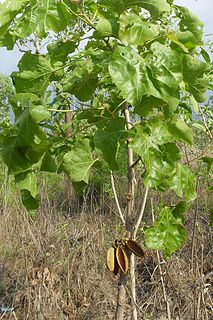
Brachychiton megaphyllus, commonly known as the red-flowering kurrajong, is a tree of the genus Brachychiton found in northern Australia.
Brachychiton spectabilis is a tree of the genus Brachychiton found in northern Australia. It was described by Gordon Guymer in 1988.
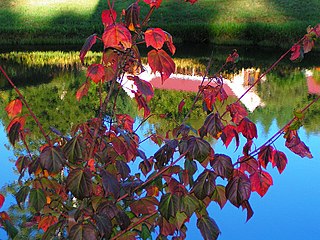
Acer pectinatum is an Asian species of maple. It is native to the Himalayas and nearby mountains in southwestern China, Myanmar, and the northeastern part of the Indian Subcontinent.













